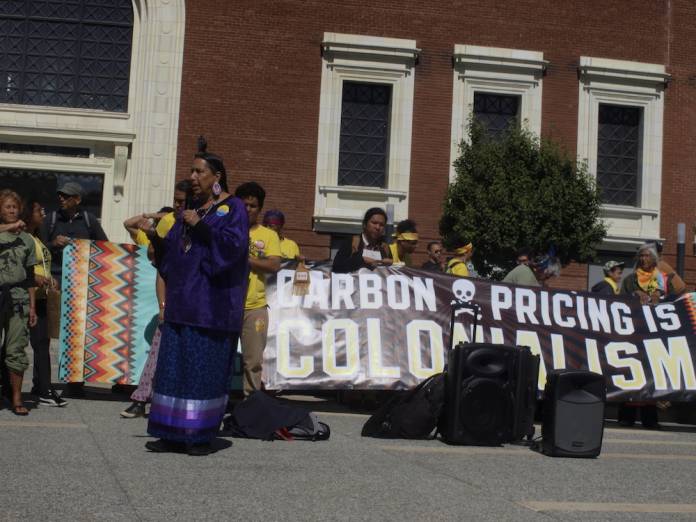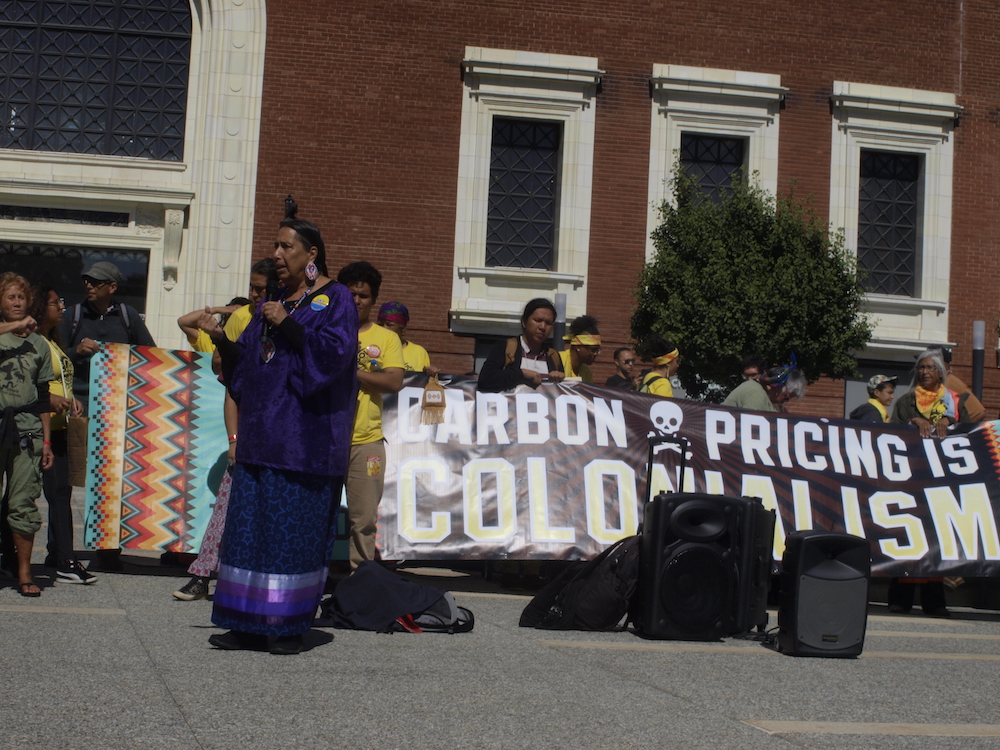
As Governor Jerry Brown and former New York City Mayor Michael Bloomberg opened the Global Climate Action Summit Thursday, they were greeted by hundreds of protesters and direct action outside Moscone Center, led by the indigenous and frontline communities hit hardest by climate chaos.

For nearly three hours, protesters (two of whom were arrested) blocked summit entrances, chanted and unfurled banners stating, “Keep it in the Ground,” and “Climate Capitalism is Killing Our Planet.” As one speaker in front of Moscone Center put it, “we are the ones who are dying.”
From the mass 30,000-strong climate justice march Saturday Sept. 8, to numerous protests and educational events, the message has been loud and clear: indigenous and frontline communities are bearing the most severe, immediate brunt of climate disasters, and market-driven approaches are exacerbating and prolonging the crisis.
Indigenous activists drew a direct connection between Brown’s market-led carbon trading system and intensifying fossil fuel extraction: pollution credits in California, for instance, can be used to expand climate-wrecking emissions elsewhere.
“You can’t buy and sell the earth with your carbon trading schemes,” said Casey Camp-Horinek, an elected councilwoman for the Ponca Nation of Oklahoma. Jerry Brown, she said, “has entered the largest carbon trading scheme the world has ever seen.” She termed this market-led approach “false economy, false solutions.”
In her community in north-central Oklahoma, the toxic mix of refineries, injection wells, and fracking by Phillips 66 and other fossil-fuel extractors is producing what Camp-Horinek calls “an environmental genocide…Every single family has a member with cancer. We have averaged a funeral a week.” The intense fossil fuel production in her area is contributing to more autoimmune, cardiovascular, and respiratory diseases, she says, and even “kids being born with bone cancer.”
All of the 30 injection wells in her area are leaking methane into local tribal drinking water sources, she added.
In North Dakota, home to a fracking boom in recent years, fossil-fuel extraction has intensified as a direct result of carbon trading and offset programs pushed by Brown and others, said Kandi White, an organizer from the Mandan, Hidatsa, and Arikara tribes in that state.
“Instead of keeping fossil fuels in the ground, they want to continue to making money off it, and it hurts us,” she said. People in her area, she said, suffer more cancers, and more babies are born with upper respiratory illnesses. “The planet is screaming at us,” she said.
White applied for credentials to the summit but wasn’t allowed access. “Those of us that are suffering the worst,” she said, are not being allowed in.
Asked about solutions to the crisis, White replied, “Scientific, commonsense, traditional understanding. Capitalism, which is the carbon market system, is the problem—so carbon markets and capitalism can’t possibly fix the problem. We need to leave the remaining fossil fuels in the ground,” where, she noted, 50-80% of what’s left lies on and in native peoples’ lands. “That’s why our voice is so prominent and should be heard. Yet we are the ones locked out, we’ve always been locked out.”
Inside the summit halls, protesters briefly disrupted Bloomberg’s speech, chanting, “our air is not for sale,” and were removed by security,NBC Bay Area reported. Bloomberg lobbed a stunning rebuke at the protesters, likening them to right-wing border wall advocates: “We’ve got environmentalists protesting an environmental conference. It reminds me of people who want to build a wall along the Mexican border to keep people out from a country we go to for vacations.”
Bloomberg and Brown may seem like climate action heroes compared with Donald Trump, but these leaders are “patting themselves on the back for insufficient action,” said David Turnbull, a spokesperson for Oil Change International. “They’re not standing up to the fossil fuel industries. Governor Brown has been very resistant to our demands to keep fossil fuels in the ground.”
While Brown has snared headlines for signing legislation to make California’s electricity supply 100 percent renewable by 2045—and signing an executive order directing state agencies to make California carbon neutral by that same year through carbon sequestration and reduction approaches—climate activists say his policies on carbon trading and maintaining fracking and fossil fuel production are causing immense harm.
As Turnbull put it, “pushing pollution around, trading pollution around, means that the most vulnerable communities bear the brunt.”
Brown’s policies “have allowed fossil fuel companies to create a living hell for Californians whose health and safety are threatened by toxic drilling operations,” Cesar G. Aguirre, an organizer with the Central California Environmental Justice Network, said. “People in California’s Central Valley are forced to breathe some of the dirtiest air in the nation, and Kern County has the worst air in the United States, because of toxic oil drilling. The climate crisis isn’t just happening in our atmosphere, it’s also happening in our bodies when we breathe this poisoned air.”
Solidarity to Solutions
As sea levels and climate chaos rise, so too are the indigenous and frontline communities. The climate justice movement, once characterized as white and middle-class, is increasingly led by communities of color and indigenous people who are suffering the most direct, severe effects of climate change.
Joining forces in the It Takes Roots Alliance, several major coalitions—The Climate Justice Alliance, Grassroots Global Justice, Indigenous Environmental Network and Right to the City—organized a week of Solidarity to Solutions actions and education.
The complexity and diversity of climate-related battles and local solutions was on full display at the “Sol 2 Sol” event in La Raza Park in the Mission District this past Tuesday. Perched on park’s top slope, Gwich’in Indian Nation leader Bernadette Demientieff told a group of young climate activists what’s at stake for her people, who have lived with the caribou in Alaska’s northeastern Arctic Circle for thousands of years.
“We’re fighting for our human rights, we’re fighting for our food security, we’re fighting for our land,” said Demientieff, executive director of the Gwich’in Steering Committee, which is also battling to protect traditional caribou herds in the Alaskan Wildlife Refuge, as new threats of oil drilling and pipelines close in around them.
In the Gwich’ins’ home of northern Alaska, caribou herds have been decimated by climate change’s impacts on vegetation—plummeting by 57% since 2010, according to Demientieff. “Our future generations aren’t going to have land, water, and healthy animals to hunt if we don’t take care of them.”
Two days after an indigenous-led climate justice march roughly 30,000-people strong, and two days before the Global Climate Action Summit’s more staid, officious convening, climate justice activists from around the world gathered in La Raza Park to strategize community-based solutions to the climate disasters wreaking havoc on indigenous and other frontline communities.
Bathed in an unseasonably warm sunny afternoon this Tuesday, hundreds of activists, from Native American Alaskan tribes based in the Arctic Circle to Bay Area communities of color battling gentrification and pollution, shared the public space to tell their stories from the front lines of climate change.
Alaskan Rosemary Ahtuangaruak, from the 500-person Native Village of Nuiqsut on the Arctic Ocean, said more than 75 people in her community are suffering respiratory illnesses from fast-encroaching oil industry developments by Conoco Phillips, Exxon, British Petroleum and others.
“They exempt human health protections to increase profitability,” said the community health aide. She reports more cases of heart disease, thyroid illnesses, and babies being born in respiratory distress, but, “they won’t connected to resource extraction.”
Another health and nutrition threat from climate change: their ice cellars are melting, making it harder to freeze and store meat, and ice fishing is getting tougher as people fall through thinner ice on freezing rivers.
Down the hill, Amee Raval and Shina Robinson, organizers with the Asian-Pacific environmental network, explained that a key part of climate justice is making renewable energy accessible and affordable for low income people and communities of color. This “energy equity” requires public funding and community involvement to make these connections between low income communities and renewable energy, Raval said.
One small step in that direction: the California Public Utilities Commission now provides a 20 percent savings on solar energy to make it more accessible for lower income communities, according to Raval.
Building connections between renewable energy access and stable housing, along with community-based job creation, is key to solving this climate justice puzzle, Robinson added. “We want to make sure that the people in those buildings get to stay and enjoy these benefits” of solar access, she said. “We are mindful of every policy to make sure that job creation for communities of color is a part of it. When it comes to renewable energy jobs, she said, “is missing from those industries are folks of color and women.”
Antonio Díaz, director of People Organized to Demand Economic and Environmental Rights, which hosted the Solutions event, stressed the importance of “showcasing on-the-ground climate resilience.” He pointed to community-based solutions such as Hummingbird Farm in the Excelsior, and efforts to create a new public park in the Mission. “Reclaiming public lands is part of building climate resiliency, especially in a city where gentrification is such a crisis and our community fabric has been torn,” he explained. “Here in San Francisco, what’s being commodified and extracted is land.”
Díaz noted that while San Francisco has been aggressive in reducing waste and emissions, “there’s something contradictory in a city that says it’s committed to sustainability and at the same time it displaces people” through evictions and gentrification—leading to more long-distance commuting, more traffic congestion, and more pollution. Linking climate and economic justice issues, Díaz said San Francisco needs to “make a commitment to be a zero-waste city and a zero-displacement city.”

